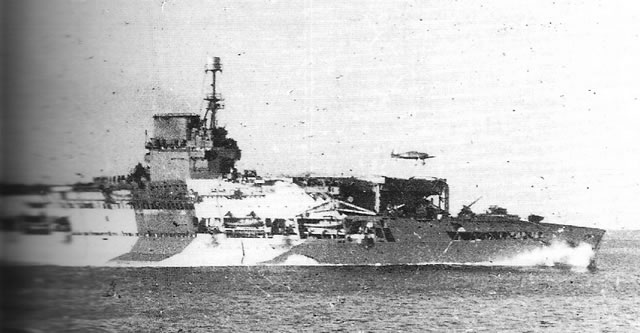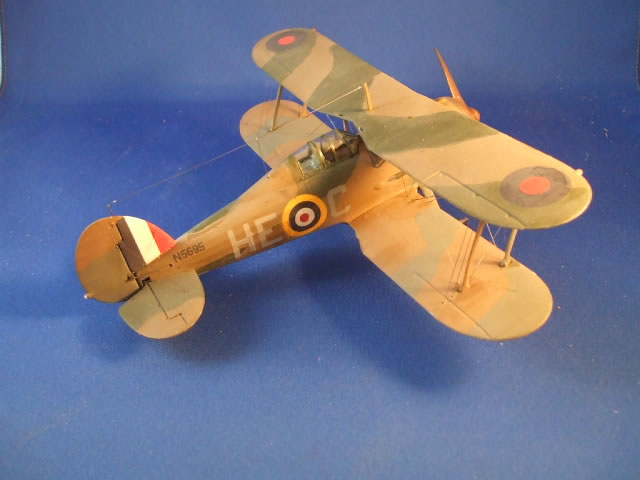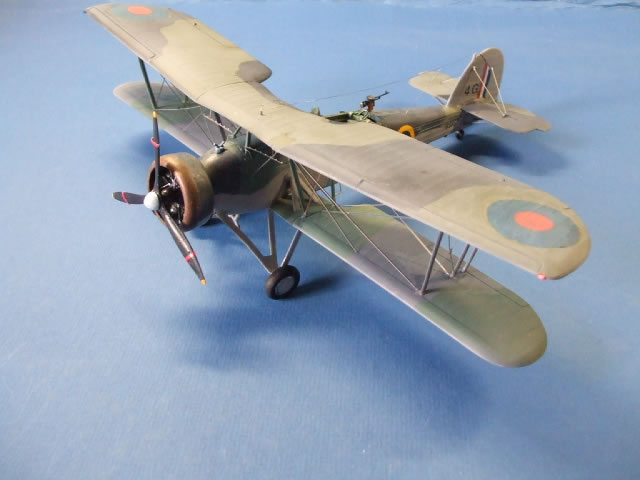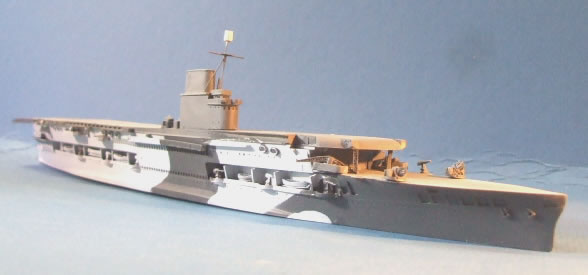HMS Glorious and Embarked Aircraft
8 June 1940
by Joe Lyons

|
HMS Glorious
The day before her loss (FAA Museum with permission) |

HyperScale is proudly supported by Squadron
In early April 1940 British and French ground, air and naval forces responded to the German invasion of Norway; the Phony War was over. Part of that response included the carrier HMS Glorious, actively involved from April 14 until June 8.
April 14 Glorious, a unit of the Mediterranean Fleet, sailed from Gibraltar for the UK in response to orders to join the Home Fleet for operations off Norway.
April 18 Arrived in the Clyde
April 21 812 and 825 NAS (Swordfish) flown off to Prestwick, leaving 802 (Sea Gladiator) and 823 (Swordfish) NAS on board; sailed from the Clyde and embarked 18 Gladiator fighters of No. 263 Squadron (landed on by naval pilots)
April 22 823 disembarked and 804 (Sea Gladiator) and 803 (Skua) NAS embarked
April 23 Sailed from Scapa Flow with Ark Royal for Operation ‘DX’ to provide fighter cover off Namsos and Aandalsnes and fly off No 263 Squadron RAF to frozen Lake Lesjasskou
April 27 Remaining 4 Skuas of 803 NAS transferred to Ark Royal; Glorious then returned to Scapa Flow to refuel and embark replacement fighters, arriving April 28.
April 30 Embarked 18 Sea Gladiators for 802 and 804 NAS plus 823 NAS (Swordfish)
May 1-May 18 Re-joined task force off Norwegian coast; left the same day, arriving Greenock. There embarked 18 Hurricanes of 46 Squadron via lighter. Sailed in company with Furious on May 14. Rejoined Ark Royal off Narvik but could not fly off 46 Squadron due to bad weather.
May 22 Departed for Scapa Flow to refuel, arriving May 23.
May 24 Sailed again with 46 Squadron who’s Hurricanes were flown off on May 26.
May 28 3 Sea Gladiators of 802 NAS shot down shadowing He 115 floatplane.
May 30 Back at Scapa Flow to refuel. Sailed on May 32 for Operation ‘Alphabet’ (evacuation of the BEF from Narvik). Only 802 and 823 NAS embarked to leave space for such RAF aircraft as could be recovered from shore.
June 6 Recovered 10 Gladiators of 263 Squadron and 7 Hurricanes of 46 Squadron (first time high performance monoplanes fighters had landed on a British carrier).
June 8 Sunk by gunfire of German battlecruisers Scharnhorst and Gneisenau between 1600 and 1730 southwest of Narvik.

HMS Glorious as built
HMS Glorious was one of the Royal Navy carrier conversions from ‘gun’ ships (Courageous was the other of this class) allowed to be completed by the Washington Naval Treaty of 1922. Originally built as ‘large cruisers’ with four 15” guns during WW I, their size and speed made them obvious candidates for conversion to carriers. And, in a peacetime navy they did not ‘fit’ with other big gun ships, and were already in reserve.

Glorious launching 46 Sqn. Hurricanes, 26 May 1940. FAA Museum by permission.
Fleet Air Arm standard types of the time included Swordfish, Sea Gladiators and Skuas. As we have seen, Skuas were disembarked on Glorious’ last operation to make room for the RAF vagabonds.
FAA
Swordfish Mk I – 823 Squadron FAA (five embarked)
Sea Gladiator Mk I – 802 Squadron FAA (six embarked)
RAF
Hurricane Mk I – 46 Squadron (10 embarked)
Gladiator Mk II – 263 Squadron (seven embarked)
(Aircraft: 1:48; ship: 1/700) [painting and markings covered separately]
Hurricane I

This is the Airfix release of the Mk I. I hesitate to comment too much on its outline because, while Hurricanes kits do not inspire as much visceral emotional response as Spitfires, strongly held opinions are out there. Dimensionally, it seems to fit the published length and wing span citations. Two prop options (D/H and Rotol) are offered; I used the D/H prop as possibly more common in the spring of 1940. Cockpit detail is crude and elementary. I solved this little problem with a closed canopy. The rest of the kit is certainly adequate in my opinion. Straightforward assembly; some filler needed at the wing/fuselage seam.
Gladiator II

The Lindberg kit – still a competitor after all these years. I used a True Details cockpit under a closed canopy. Rigging wires and antenna done with .007 steel wires. Gun barrels and exhausts drilled out.
Swordfish

The Artiplast kit, purchased by me in 1972 in California and has traveled since to Rhode Island, back to California, to Hawaii, to Guam, to Florida, to New Jersey, ending up in North Carolina. Sometimes you just can’t rush things and as HS poster John Krukowski observes, “Gotta let 'em age first, to make sure they're all done warping.” Definitely the cheapest Swordfish in this scale, accurate in outline but of course very, very basic. The instructions claim it to be 1:50 scale, but my measurement of the upper mainplane indicates its really 1:46 scale.
Those yawning cockpits could not be ignored, so I dressed them up a bit with an Eduard cockpit P/E set intended for the ‘other’ 1:48 Swordfish, plus some sheet plastic coamings and other scratch bits. Also used Aeroclub Lewis gun and spare magazines.
Tamiya after-market set for the String Bag provided the rigging wires and engine/cowling do-dads. Tamiya of course assumes you’ve already tapped a line of credit to buy its Swordfish, so no mounting instructions are included. But with the marvelous cutaway in Reference F, I was able to figure it out, with assistance from a copy of the Tamiya kit instructions.
The kit is seaplane-only, so the landing gear was obtained from an Aeroclub update kit for this aircraft, which also provided a white metal prop and arrestor hook.
Sea Gladiator

The Roden kit, essentially OOB except for the rigging. Excellent representation of the complicated cylinder exhausts inside the cowl ring. Although marked as a ‘Sea Gladiator,” the external arrestor hook proud of the fuselage is a characteristic of an “Interim Sea Gladiator.” converted from existing RAF airframes. In truth the visual difference is minor. .007 wire again for the bracing wires and antenna. The kit includes the dingy pack allegedly used with the Sea Gladiator, and there is a picture of one on a prototype, but I’ve not found one of an operational aircraft with it, so it’s not on the model.
HMS Glorious

The HP Models 1:700 resin kit appears to be very competently done. The parts layout is well organized; there is no assembly sequence provided but exploded parts diagrams are adequate for the task. One inaccuracy probably unavoidable in this scale, is the level flight deck. Glorious, Courageous and Furious as converted to carriers had a ‘humped’ flight deck forward to accommodate the then-current longitudinal arrester wire system.

The hump remained after this system was abandoned in the late ‘20s, and all three ships carried it to the end of their lives.
Looking at the chronology of the ship’s last month, superimposed on what was going on with Air Ministry fighter markings in the same month, there is much ambiguity in the written word and photos. Hence all the references I consulted trying to determine accurate paint and marking schemes. The serials and RAF squadron codes are known for all 8 June Glorious aircraft, however with the possible exception of 823 Swordfish individual aircraft codes are not. I have therefore assigned “C” to the Gladiator and “A” to the Hurricane. Ref H identifies a specific Sea Gladiator by serial and code that was embarked; this is not confirmed by reference T, from whose list of serials I have chosen to mark the Sea Gladiator. The aircraft code “A” was arbitrarily assigned to this model. The Swordfish’s marking “G4G” appears under the tips of the upper mainplane and on the fin, but I assuming the directive to delete the carrier ID letter, in this case “G” (for “Glorious”) had been complied with by 8 June.
RAF-types
The Dark Green/Dark Earth upper surfaces were in effect when the war started, as was the so-called “IFF” scheme of black and white undersides, based on the fuselage centerline. Confusing Air Ministry directives resulted in many variations on the IFF scheme.
FAA Types
Both the Sea Gladiator and the Swordfish had upper surfaces in the Air Ministry four-tone scheme for biplanes. For FAA aircraft this was Extra Dark Sea Grey/Dark Slate Grey (actually a green) for the upper wing, tail plane and those parts of the fuselage not in shadow. The lower wings and those parts of the fuselage in shadow were in the lighter shades of Dark Sea Gray and Slate Gray [got all that?]. The lower surface of the wings (Swordfish only), rudder and tail planes were in Sky Grey. The fighter used the IFF scheme.
The really fun part was the sides of the fuselage. Those airplanes repainted from the peacetime overall silver in 1939 had a straight demarcation line high in the side, below which was Sky Grey. New production airplanes followed a wavy pattern per Air Ministry directive. From its serial, the Sea Gladiator was a production, not an interim-converted-from-an RAF airframe, so it got the wavy line. The Swordfish (no pictures survive of 823 aircraft) conforms to photos taken in April of another Glorious stringbag unit. (Reference N)
National insignia roundels were Type B on the upper wings for all aircraft, Type C for the lower wings of the Swordfish (no underwing insignia for the fighters), and Type C1 on the fuselage. The so-called fin flash was introduced in May. I’ve put it on all the fighters where it occupies the entire fin, but surviving photos of the Swordfish show it small enough to provide room for the ship-squadron letters and number.
HMS Glorious
Painting ship models has always been a challenge for me, but this one was relatively easy. Overall light grey with a dark gray simple camouflage pattern, based on the photos. Documentation of RN early-war camouflage is thin on the ground, but for Glorious we have available port and starboard photos of her scheme within days of her loss.
The Norway operations represented some firsts for western navies operating carriers. Three carriers (Glorious, Ark Royal, Furious) were engaged and in coordination.
Additionally:
- The concept of a radar guard ship (usually a cruiser) – a first in naval warfare.
- Transport of RAF fighters into and out of an active theater had been done pre-war from the beginning of RN carrier operations when carriers were used to move aircraft around the empire. But the landing aboard of high performance aircraft not equipped with the gear for this activity or pilots trained in its technique was unique.
- Active air defense and rudimentary fighter direction
- Strikes against a variety of shore targets
The loss of Glorious and her escorts was embarrassing and controversial. A thinly escorted capital ship in hostile waters was found and destroyed by battleships. Both escorting destroyers were sunk as well; total RN loss of life that day exceeded 1500. What actually transpired on the carrier is little known because of the heavy loss of life. It is known that there were personal issues between the CO and the FAA aviators, particularly Commander (Flying). Apologists for the failure to operate aircraft that day claim all the extra aircraft on board fouled the flight deck, exacerbated by the inability to strike below non-folding wing Hurricanes. Both claims are false. The capacity of the upper and lower hangars were adequate to house all the aircraft aboard on 8 June, including the Hurricanes whose dimensions and that of the lifts did not preclude lift transfer below - if the will had existed to do it. See Reference O.
Unanswered questions include:
- Why had no regular dawn searches been flown that day to sanitize the ship’s locality? They had been flown by Glorious on previous Norway operations.
- Why were not Swordfish held in readiness (armed and spotted for launch) in a war zone?
- The ship should have capable of evading her pursuers but apparently did not. Why?
With Thanks to:
Graham Boak: who provided advice on the topic and insight as to relevant publications, both of which were of great value.
Bruce Archer: who provided instructions from the Tamiya Swordfish, thus greatly assisting my austere cockpit detailing and the biplane rigging.
Fleet Air Arm Museum Yeovilton (Anna Clark)
And, a moment’s reflection if you please, on:
Those Royal Navy personnel who perished that day, and in particular the gallant RAF pilots who risked all, did the impossible, and did not live to survive the experience.
-
Balance, T., Sturtivant, R. (1994). The Squadrons of the Fleet Air Arm. Tonbridge, Kent: Air-Britain
-
Bowyer, M, Rawlings, J (1979). Squadron Codes 1937-56. Cambridge: Patrick Stephens.
-
Bower, M. (1969). Fighting Colours RAF Fighter Camouflage and Markings 1937-1969. London: Patrick Stephens.
-
Brown, D. (1975). Carrier Fighters 1939-1945. London: Macdonald and Jane’s.
-
Brown, D. (1974) Carrier Operations in World War II The Royal Navy.
Annapolis MD: Naval Institute.
-
Brown, E (1987). Wings of the Navy. Annapolis MD: Naval Institute Press
-
Friedman, N. (1988). British Carrier Aviation. The Evolution of the Ships and Their Aircraft. Annapolis MD: Naval Institute
-
Goulding, J, Ward, R. (circa 1971). Camouflage & Markings RAF Northern Europe 1936-1945 Number 5 Gladiator, Gauntlet, Fury, Demon. London: Ducimus Books
-
Hall, A., Huntley, I. (1984, April). Fairey Swordfish. Scale Aircraft Modelling, 6, 294-309.
-
Harrison, W. (2001). Fairey Swordfish in Action. Carrollton TX: Squadron/Signal Publications.
-
Harrison, W. (2003). Gloster Gladiator in Action. Carrollton TX: Squadron/Signal Publications
-
Hobbs, D. (1996). Aircraft Carriers of the Royal and Commonwealth Navies. London: Greenhill Books
-
Jones, R. (circa 1971). Camouflage & Markings RAF Northern Europe 1936-1945.Number 8 Hawker Hurricane. London: Ducimus Books.
-
Lloyd, S. (2008). Fleet Air Arm Camouflage and Markings Atlantic and Mediterranean Theatres 1937-1941. Stamford, Lincolnshire, England: Dalrymple & Verdun.
-
Lyons, J.E. (2008). Loss of HMS Glorious (letter). Warship International, XLV, 2, 98.
-
Sands, G. (2009). Fairey Swordfish. Scale Aircraft Modeling, 10, 36-47
-
Scutts, J. (1986). Hurricane in Action. Carrollton TX: Squadron/Signal Publications.
-
Taylor, H. (1974). Fairey Aircraft since 1915. Annapolis MD: Naval Institute Press.
-
Thomas, A. (2007). Royal Navy Aces of World War 2. New York: Osprey Publishing.
-
http://surfcity.kund.dalnet.se/gladiator_raf_263.htm [Probably the definitive account of the fates of all 263 Squadron Gladiators that got to Norway.]
-
http://surfcity.kund.dalnet.se/gladiator_glorious.htm [Håkans Aviation page - The sinking of HMS Glorious and loss of 263 Squaddron]. – A very complete account of the events of 8 June, particularly the RAF aircraft and personnel, and the fates of the latter.]
Text and Images Copyright ©
2010 by Joe Lyons except where mentioned otherwise
Page Created 21 July, 2010
Last Updated
21 July, 2010
Back to Reference Library
|
Home |
What's New |
Features |
Gallery |
Reviews |
Reference |
Forum |
Search